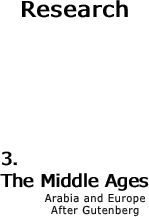 |
||||
 |
||||||||||||
 |
Arabia and Europe 500 Rhetorius introduces triplicities of elements into the zodiac. 600 Church condemns astrology and attempts to suppress it in the following centuries. 650 In the Etymolgiae of Isodore, Bishop of Seville, it is mentioned that astronomy and astrology were complementary arts in antiquity. 700 Monks in monasteries learn about astrology in Classical literature, and investigate it in secret. 750 Muslim astrologers Masha'allah, al-Kindi, Abu Ma'shar revive the astrology of Hellenistic Greece, based on Ptolemy's Tetrabiblos and works of Firmicus. Ibrahim Al-Fazari invents astrolabe. Accuracy of Ptolemy's work is enhanced with Arabic numerals and zero. Stars are identified and observatories built. 850 Well-known Arabic astrology texts appear such as Treatises of Albategnus and The Flowers of Astrology by Albumazar. Harun-al-Rashid builds observatory in Baghdad and sets up renowned school for astrology in Cairo, Egypt. 900 Son of Harun-al-Rashid, Caliph Al-Mamun establishes House of Wisdom were the Tetrabiblos was translated and used as basis for further astrological study. 950 Ibn Unis, Muslim astronomer compiles Hakimite tables of planetary motions. ..
1000 Firdausi, Abul-Qasim Mansur, great Persian poet writes Shah-Namah which contains many astrological references. Astrology flourishes in Byzantium through Psellus, Caerularius and Xiphilin. 1200 University of Bologna becomes center for medical astrology. Tetrabiblos is trans- lated by Plato of Tivoli. Adelard of Bath (England) brings astrology to Europe. Sacrabosco writes Sphaera Mundi, early English textbook of spherical astrology. 1250 Albertus Magnus recommends Tetrabiblos. Roger Bacon links ancient magic and astrology in Speculum Astronomiae.Guidi Bonati is famous astrologer of his time. Thomas Aquinas accepts philosophical aspect of astrology. Emperor Frederick II uses astrologer Michael Scot. Astrology is taught at Cambridge University. 1280 Johannes Campanus devises new method of house division and serves Pope Urban IV. 1327 Cecco D'Ascoli, astrology teacher and astrologer to Duke of Florence is burned at the stake for his teaching that Christ's story was astrological. 1375 Chaucer, first great English poet uses astrological references. .. After Gutenberg 1400 Invention of printing (1455 by Gutenberg) allows astrological records and writings stored in monasteries, libraries or royal palaces to be mass-reproduced and dis- tributed throughout Europe. Astrology is taught in many universities. Ideal astrological times are selected for specific ventures. Astrologers serve in royal palaces of France, England, Italy, Austria. Astrologer Luc Gauric serves Popes Julius II, Leo X, Clement VII and Paul III. Under Leo X, Vatican promotes research and instruction in astrology. Astrological themes appear in stained-glass windows of cathedrals, in facades of public buildings, frescos, art. Book of Hours, rich in astrological illustrations, appears in France and is dedicated to royalty and aristocracy. This book attracts wealthy to astrology. The most famous version is the Tres Riches Heures by the Limburgs. 1431 The Amicus Medicorum, by Jean Ganivet, is standard reference used by doctors for next two centuries to diagnose and cure illness with astrology. 1437 At the University of Paris ideal times for bloodletting are selected on astrological basis. 1450 Charles 5th of France is also astrologer. Pope Sixtus IV, first of the great Pope- astrologers. Writings of Oresme, Peter D'Ailly, Jean Gerson show that astrology is valid and part of science. 1474 The first ephemeris ad XXXII Annos Futuros by Regiomontanus (Johann Muller) is printed in Nuremberg, 2nd in Venice. 1475 Famous Lorenzo Medici uses astrologers.
1500 Leonardo da Vinci draws illustrations associating astrological symbols with parts of the body and terrestrial life in Zodiac Man and Sphaera manuscripts. Boticelli paints famous 'Venus and Mars.' 1508 Luca Gaurico, author of Tractatus Astrologicus publishes Oratio de Inven- toribus et Astrologiae Laudibus in which he defends judicial astrology. 1510 Lucrezia Borgia explores astrological philosophies with astrologers and her father Pope Alexander VI. 1520 German artist Beham produces engravings showing functions of planets. |
|||
|
||||
|
Opdateret 08/01/2020 - ret til ændringer forbeholdes |
||